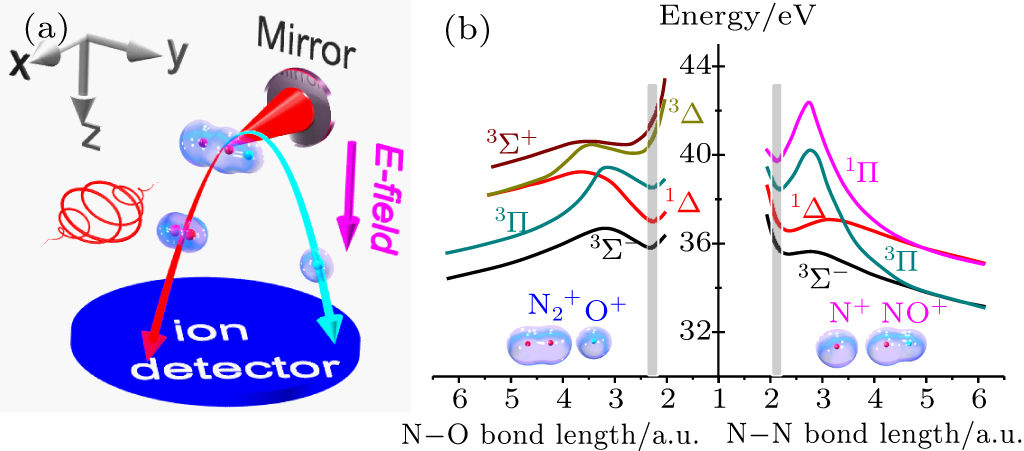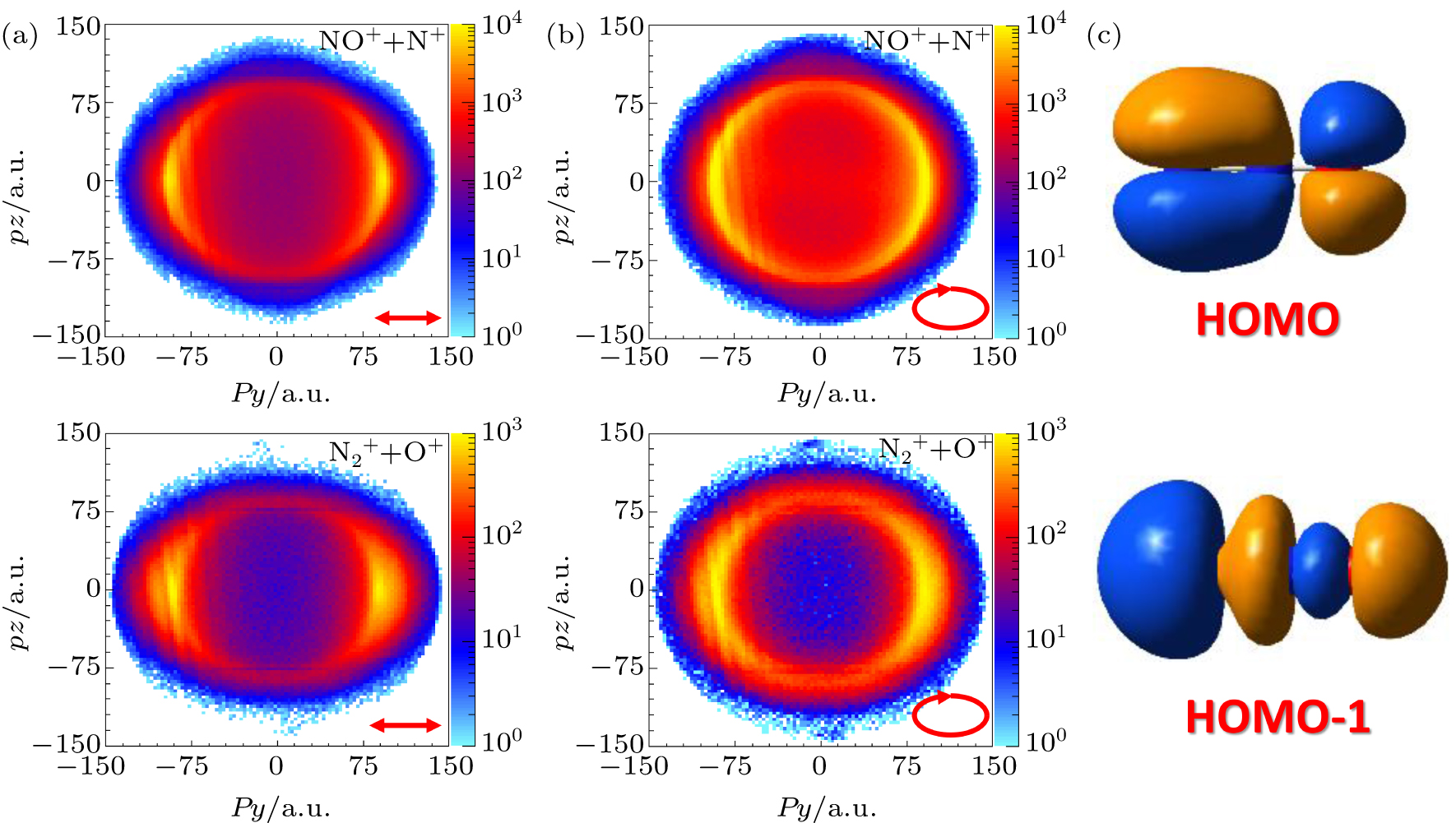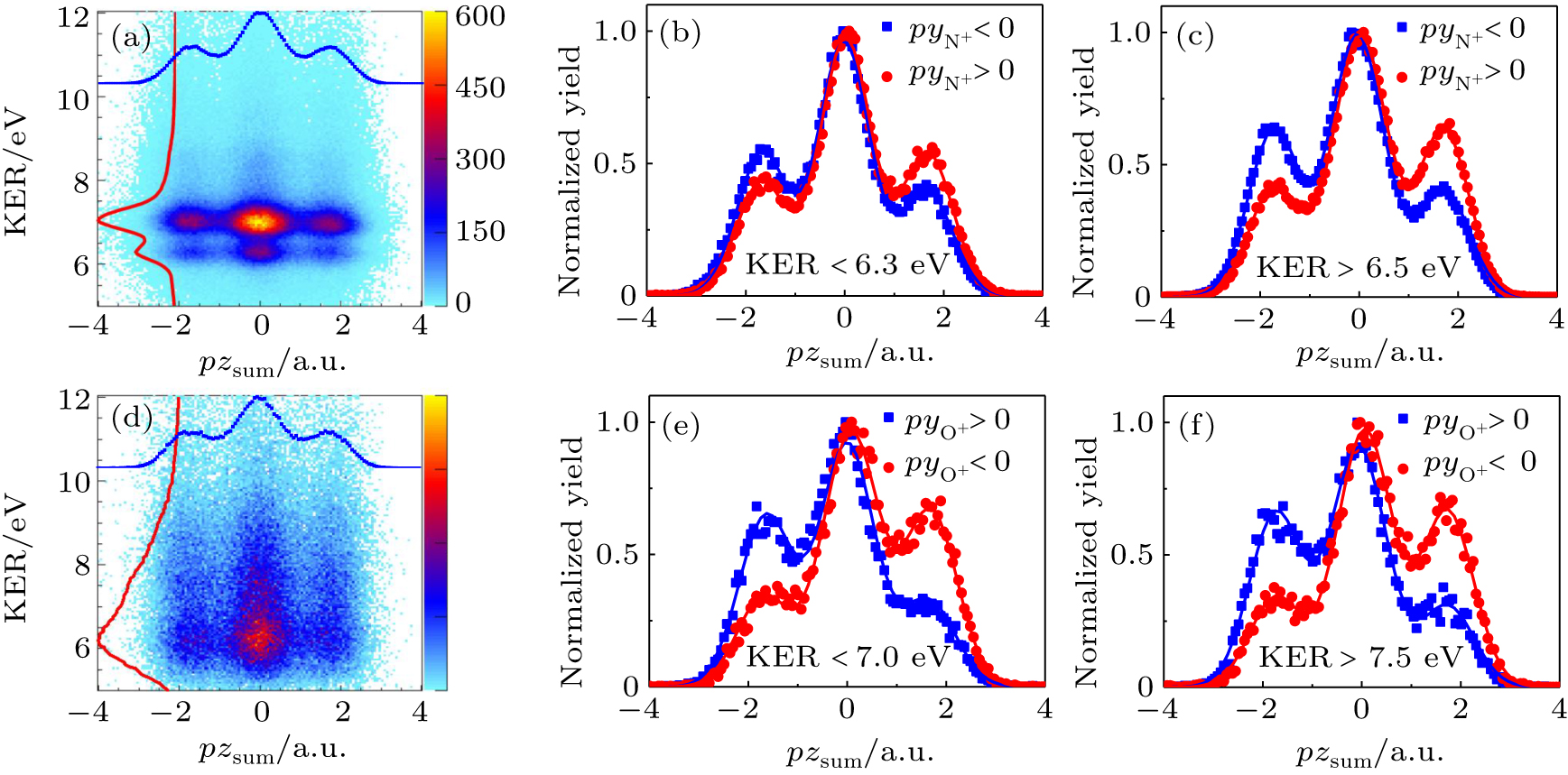† Corresponding author. E-mail:
We experimentally investigate Coulomb exploded directional double ionization of N2O molecules in elliptically polarized femtosecond laser pulses. The denitrogenation and deoxygenation channels are accessed via various pathways. It leads to distinct asymmetries in directional breaking of the doubly ionized N2O molecules versus the instantaneous laser field vector, which is revealed by tracing the sum-momentum spectra of the ionic fragments as a recoil of the ejected electrons. Our results demonstrate that the accessibility of the Coulomb exploded double ionization channels of N2O molecules are ruled by the detailed potential energy curves, and the directional emission of the fragments are governed by the joint effects of the electron localization-assisted enhanced ionization of the stretched molecules and the profiles of the molecular orbitals.
Driven by a strong laser field, a molecule might break after removal of one or several electrons. The directional breaking of the molecular bond can be steered by using waveform controlled intense ultrashort laser pulses, which is significant for the manipulation of molecular chemical reactions. Governed by various mechanisms, it can be achieved by controlling the carrier envelope phase (CEP) of near-infrared few-cycle laser pulses[1–9] or the relative phase of two-color multi-cycle femtosecond laser pulses.[10–15] Recently, the directional bond breaking control was realized in two-dimensional space by using phase-controlled orthogonally or circularly polarized two-color laser fields.[16–18] However, the molecular bond breaking control mainly focused on the diatomic molecules, and only few triatomic[19–21] and polyatomic molecules[22–24] were investigated which are more interesting with rich dynamics.
In the present work, we experimentally investigate the Coulomb exploded double ionization of N2O molecules, where two different channels are produced, i.e., 

 | Fig. 1. (a) Scheme of the experimental apparatus. (b) Relevant potential energy curves of the N2O2+, adopted from Ref. [35]. The gray band indicates the Frack–Condon vertical transition range for the photoionization of N2O. |
The measurements were performed in a standard reaction microscope of cold target recoil ion momentum spectroscopy (COLTRIMS),[25,26] as illustrated in Fig. 

Figure 
Driven by elliptically polarized laser fields, the electron recollision excitation is mostly suppressed and thus the double ionization of molecules mainly occurs via a sequential process by releasing two electrons one after the other. The sum-momentum of the two emitted electrons is the convolution of two individual electrons.[28,29] In our counter-clockwise rotating elliptically polarized laser field, the electrons are mainly released when the instantaneous laser field points to the −y (or +y), which will end with a final momentum along −z (or +z) as a consequence of angular streaking of the elliptically polarized pulse.[30] According to the law of momentum conservation of the breaking system, the correlated molecular ions receive an equivalent drift momentum in the opposite direction. Therefore, the electrons sum- momentum is mapped into the sum-momentum spectrum of the correlated fragment ions, e.g., 
As mentioned above, the strong laser field ionization dynamics of N2O depend on its bond orientation with respect to the light polarization. The molecules aligned parallel to the major axis of the elliptically polarized laser field are predominantly ionized, as shown in Fig.
To get quantitative insights of the asymmetric dissociative double ionization of N2O molecules, we numerically fit the ion sum-momentum spectra by considering the convolution of the momenta of two sequentially released electrons,[29] as shown in Figs. 























The electronic configuration of the ground state of the N2O molecule is (
As shown in Fig. 











For the low-KER region of the denitrogenation channel, the drift momenta of the first and second electrons are almost equal which indicates that they are released by laser fields of similar intensities, i.e., either within a tiny time window or at different time with one in the rising edge and the other in the falling edge of the laser pulse. However, for the high-KER region, the drift momentum of the second electron is much larger than the first electron, which indicates that the second electron is released by a higher field strength.[28] Since the low-KER peak was absent in few-cycle laser pulses where the molecular bond does not have enough time to stretch,[20] we suggest that the first and second electrons are released in the rising and falling edges of the multi-cycle laser pulse separated by the bond stretching in producing the low-KER peak of the denitrogenation channel. Although the saturation effect in intense laser fields will also result in similar final momenta of the first and second electrons,[36] whose influence should be minor for the modest laser intensity used in our experiments. After the first ionization step, the molecular bond will stretch, which rearranges the distribution of the remaining electrons and alters their response to the light. For instance, the mechanism of electron localization-assisted enhanced ionization[37–41] will boost the ionization rate around the critical internuclear distance of the stretched molecule by releasing the electron from the up-field core at a relative low laser intensity. The denitrogenation channel is preferred to be produced when the laser field points from O to N owing to the mechanism of electron localization-assisted enhanced ionization, which is opposite to the expected asymmetry governed by the molecular orbital profile of HOMO in producing the low-KER region. As a result, the observed asymmetry of the low-KER region is smaller than the high-KER region. Many states of N2O+ are dissociative, for instance by populating the high vibrational levels of the 


Now let us discuss the pathways towards the deoxygenation channel. As shown in Figs. 



In summary, we have experimentally investigated Coulomb exploded directional double ionization of N2O molecules in multi-cycle femtosecond laser pulses. By gating on the ejection direction of the fragment ions, asymmetric spectra of ion sum-momentum were observed for both the denitrogenation and deoxygenation channels, which indicates that the molecule prefers to be broken when the laser field points from N to O. Our results reveal the intrinsic asymmetry of the bond breaking versus the instantaneous vector of the laser field, which is determined by the joint effects of the profiles of molecular orbitals and the electron localization-assisted enhanced ionization of the stretched molecules in strong laser fields.
| 1 | |
| 2 | |
| 3 | |
| 4 | |
| 5 | |
| 6 | |
| 7 | |
| 8 | |
| 9 | |
| 10 | |
| 11 | |
| 12 | |
| 13 | |
| 14 | |
| 15 | |
| 16 | |
| 17 | |
| 18 | |
| 19 | |
| 20 | |
| 21 | |
| 22 | |
| 23 | |
| 24 | |
| 25 | |
| 26 | |
| 27 | |
| 28 | |
| 29 | |
| 30 | |
| 31 | |
| 32 | |
| 33 | |
| 34 | |
| 35 | |
| 36 | |
| 37 | |
| 38 | |
| 39 | |
| 40 | |
| 41 | |
| 42 |



